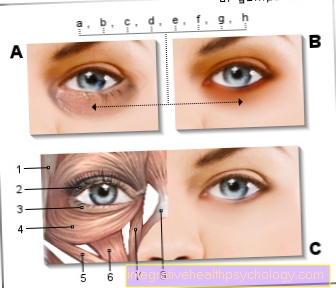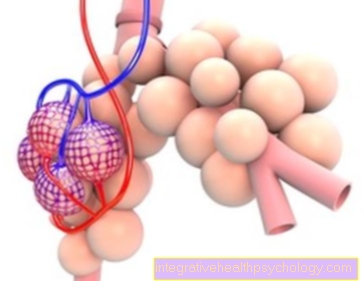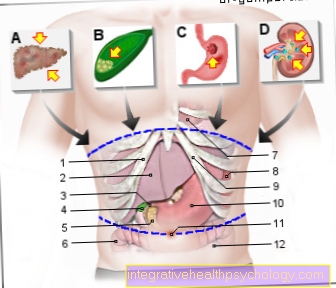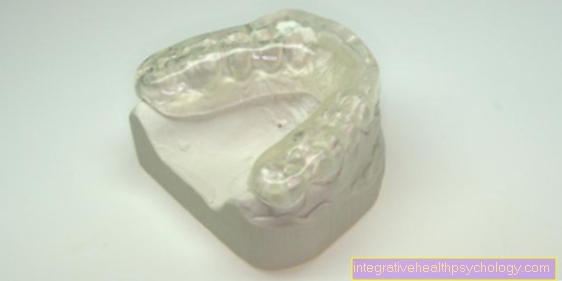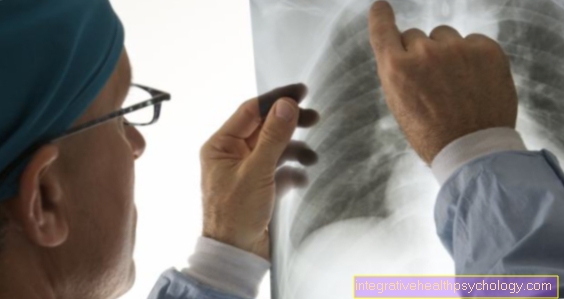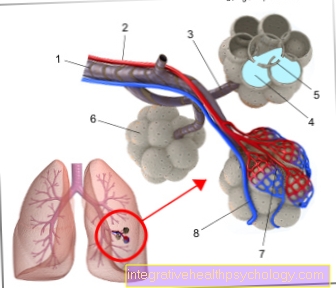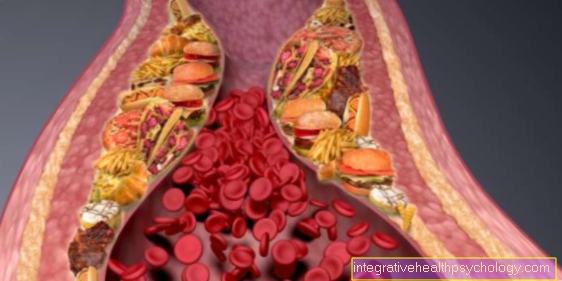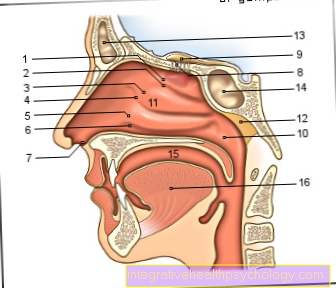capillary
definition
When of capillaries (Hair vessels) the question is, the blood capillaries are usually meant, whereby one must not forget that there are also the lymph capillaries.
Blood capillaries are one of three types of vessels that can be distinguished in humans. There are the arteries that carry blood away from the heart and the veins that carry blood back to the heart. The capillaries are located at the transition between the arterial and venous systems.
These are by far the smallest vessels, on average they are about 0.5 mm long and have a diameter of 5 to 10 µm. Since this is partly smaller than the red blood cells (Erythrocytes), which are on average 7 µm, they usually have to deform in order to fit through the capillaries.
Capillaries arise from the smallest arteries, the arterioles, then form a network-like structure with the help of many branches, which is why we sometimes speak of a capillary network, and then collect again to open into the venules.

Classification
Depending on the classification, a distinction is made between two or three forms of capillaries. First of all, there are the continuous capillaries. This means that the endothelium, the innermost cell layer of the vessels, is closed, which is why only very small molecules can pass through the vessel wall. This type of capillary is found in the skin, skeletal muscles, the heart, the CNS and the lungs, among others.
Then there are the fenestrated (windowed) Capillaries. These have pores (which are usually around 60 to 80 nm in size) in the endothelium, so that the lumen at these points is only separated from its surroundings by the very thin basement membrane. Even smaller proteins can fit through the pores. These types of capillaries are found in the kidneys (where the pores are largest), in endocrine glands and the gastrointestinal tract.
Finally, some consider the sinusoids as an extra group of capillaries. These are enlarged capillaries that have pores not only in the endothelial cell layer, but also in the basement membrane. These pores are much larger than those of fenestrated capillaries, namely up to 40 µm in size, which allows larger proteins and even blood cells to pass through. Sinusoids are found in the liver, spleen, lymph nodes, bone marrow, and adrenal marrow, among others.
Capillary endothelium
The capillary endothelium is a layer of epithelial cells that line the interior of a blood vessel. Endothelial cells are flat cells and represent the wall of a capillary. They lie on the so-called basement membrane. Depending on the type of capillary, the endothelium can be continuous, fenestrated or discontinuous and can accordingly be passable for molecules of different sizes. Depending on the task of the capillary, one of the three capillary types mentioned above occur in different tissues.
In addition to the barrier function for the exchange of substances, the endothelium has another task. The cells can produce nitric oxide. If nitric oxide is released from the endothelial cells of the blood vessels, this has an expanding effect on the diameter of the vessel. By increasing the diameter, the tissue is better supplied with blood and receives more oxygen or nutrients, for example. At the same time, the increased blood flow removes more waste products and carbon monoxide.
Structure of capillaries
The structure of a capillary is similar to a tube. The diameter of a capillary is about five to ten micrometers. Since the red blood cells (Erythrocytes), which flow through the capillaries, have a diameter of about seven micrometers, they have to deform a little when flowing through the small blood vessels. This minimizes the route over which the exchange of substances between blood cells and tissue takes place.
Since there is a constant exchange of substances between blood and tissue via the wall of the capillaries, the wall must be as thin as possible (0.5 microns). The thickness of the wall of larger vessels, such as arteries or veins, through which no mass transfer has to take place, is much greater. Arteries and veins are made up of three layers of walls. The wall of capillaries, on the other hand, consists of only one layer. This layer is made up of so-called endothelial cells.
In addition, the so-called basement membrane reinforces the wall from the outside. The basement membrane is located anywhere in the body where epithelial cells are separated from connective tissue.
In addition, so-called pericytes participate in the structure of the capillary wall. These are branched cells whose function is currently still controversial.
A distinction is made between three different types of capillaries, continuous, fenestrated and discontinuous capillaries. The structure of the individual capillaries can vary depending on the task at hand.
The continuous capillaries are mainly found in the heart, lungs, skin, brain and muscles. As the name suggests, they consist of a continuous layer of endothelial cells. These are strung together without any gaps and lie completely on the basement membrane. Through this closed layer, only very small molecules and gases can be exchanged through the wall.
The fenestrated capillaries have small gaps between the endothelial cells, which are about 60 to 80 nanometers in size and only lie on a thin basement membrane. This type of capillary is found in the gastrointestinal tract, kidneys, and hormone-producing glands. The existing pores allow larger molecules to be exchanged between the blood vessel and the tissue.
The third type of capillary is characterized by gaps (up to 100 nanometers) in the wall, which affects not only the endothelial layer but also the basement membrane. These discontinuous capillaries are also called "sinusoids". Through these pores, much larger substances, such as proteins or blood components, can pass into the tissue. They are found in the liver, spleen, bone marrow, and lymph nodes.
Functions of capillaries
The function of the capillaries is mainly the exchange of substances. Depending on where the capillary network is located, nutrients, oxygen and metabolic end products are exchanged between the bloodstream and the tissue. Nutrients are supplied to the tissue, waste materials are absorbed and carried away. Depending on the oxygen requirement of a certain tissue and the metabolic activity to be found there, this tissue is more or less densely populated with capillaries.
Blood rich in oxygen and nutrients arrives in the tissue via the capillaries. This is then released into the tissue from the inside of the blood vessel via the thin capillary wall. The tissue always needs new nutrients and oxygen. The metabolically active tissues include, for example, the brain, skeletal muscles and the heart, which is why they are criss-crossed by many capillaries. Tissues that are less metabolically active, on the other hand, have few or even no capillaries. These include above all cartilage tissue, the lens of the eye and the cornea.
At the same time, the blood in the capillaries absorbs used tissue waste products and carbon dioxide and transports them to the lungs. In the lungs, carbon dioxide is released from the blood and oxygen is absorbed in comparison to tissue. The released carbon dioxide is exhaled through the lungs and the absorbed oxygen is transported into the tissue.
Read more about this at: Pulmonary circulation
The difference in the concentration of a molecule between the blood vessels and the tissue is important for the exchange of substances. The gas or mass transfer always takes place where there is less of the corresponding substance. Because a capillary network consists of a large number of capillaries, a very large area is available for the exchange of substances. In addition, the blood flows more slowly in the capillaries, so that there is enough time for substance exchange. Together with the thin wall structure, the optimal conditions for the most effective exchange of substances are given.
That could be interesting for you too: Vascular supply to the lungs
Mass transfer
The exchange of substances is the main task of capillaries. Depending on the fabric, different fabrics can be exchanged. The difference in concentration of the corresponding substance is decisive for the exchange of substances. A substance will always migrate into the tissue where there is less of it. For example, the oxygen is exchanged from the oxygen-rich blood into the tissue in which oxygen is required. This also applies to nutrients. In contrast, the carbon dioxide or waste products that arise in the tissue are released from the tissue into the blood and transported away from there.
This gas exchange is reversed in the lungs. Oxygen is absorbed in the lungs and carbon dioxide is exhaled. Accordingly, oxygen is absorbed by the capillaries of the lungs according to the difference in concentration and the carbon dioxide that was released by the tissue passes the capillary wall in the direction of the lungs.
The blood pressure that prevails in the capillaries and the hydrostatic pressure are also important for the exchange of substances. Due to the pressure differences that arise between the upstream part of the capillary and tissue, liquid and small molecules are transported into the tissue. In the outflowing part of the capillary, the so-called colloid osmotic pressure, which is created by the proteins in the blood, plays a decisive role. This pressure causes a slight reabsorption of fluid into the blood. This is important for regulating the fluid exchange.
You might also be interested in: Cardiovascular system
Capillary effect - what is it?
The capillary effect is the behavior of liquids in which they are drawn upwards in a thin tube, for example against gravity. If you place a thin glass tube vertically in the water, you can see how the water in the tube moves up a little.
This effect can be explained by the surface tension of liquids. In addition, the interfacial tension between the liquid and the solid wall of the tube or the adhesive force play a decisive role.
The capillary effect is also important in human capillaries. Since the blood pressure is very low in these small blood vessels, the capillary effect helps to transport the blood in the capillaries.
Inflammation of capillaries
Inflammation of blood vessels is called vasculitis. Vasculitis can affect any type of blood vessel, large or small. These inflammatory diseases of the blood vessels are mostly autoimmune diseases. This means that the own immune system has an incorrect reaction to the body's own tissue and an inflammatory reaction occurs. In rare cases, drugs or infections caused by bacteria or fungi can also cause inflammation of the blood vessels. Vasculitis can also arise from other diseases, such as rheumatic diseases.
Read more about this under: Vasculitis - When the blood vessels become inflamed







